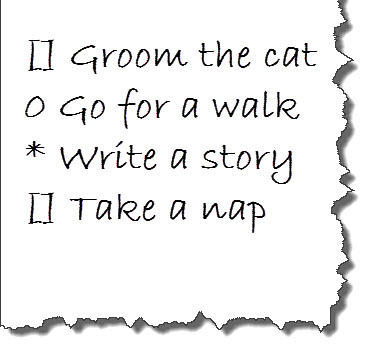Bullet journals are a combination of a journal and an organizational to-do system. They can include an index, future log, monthly log and daily log. Bullet journals use little symbols (bullets) in front of each entry. The symbols can be circles, squares, arrows, dots, etc. The circles and squares can be empty, completely filled in or partially filled in to represent different states of task completion. For example, a partially filled square next to "clean my room" could mean your room cleaning task is half finished. An event with an asterisk or star next to it could represent a very important event.
How you use your bullet journal is up to you. What you track and record in the journal is also up to you. There are no hard and fast rules. A critic of a bullet journal might argue that bullet journalers waste time tracking mundane tasks. This may be true in some cases but what the critic is missing is the fact that the bullet journaler is likely happy because they are recording and completing these mundane tasks. A Slate article says bullet journaling is popular because "it can be used to make you feel productive for doing virtually anything, no matter how important—or unimportant—it might seem to other people."
Some bullet journal writers also use colored markers or pencils. If you search "bullet journal" on Google Images you see a lot of interesting colorful results. You can be as creative as you want but it is not required. You can have a minimalist bullet journal, an artistic bullet journal or something in-between.
The torn entry below still qualifies as a bullet journal entry even though it is very boring. You could add an image of a cat with its tail wrapped around a coffee mug or five different colored unicorns standing in a row and it is still a bullet journal entry.

The popular Bullet Journal site has a getting started page that walks you through the basics. It introduces the concept of "Rapid logging," which include "topics, page numbers, short sentences, and bullets." It also covers topics, page numbers, tasks, events, signifiers, the Index and the different type of logs. If it all sounds very organized and professional that is because it is. There are even rules for the types of bullets you should use. It is better to think of these as suggestions. As BuzzFeed's entry about starting a bullet journal says, "If you don't like these symbols, you can experiment with whatever ones suit you."
Some bullet journals are more strictly organized than others. This video from Bullet Journal developer Ryder Carroll shows how to set up a bullet journal designed to get things done. It has nearly 8 million views. That's amazing. The great thing about this is that it gets some people to use journals that never would otherwise. Even if they are writing short rapid logs they are still writing.
From a productivity standpoint the official Bullet Journal rules and organization are part of the process of getting things done. There is a genius to the method involving the index, page numbering rules and striking out tasks or migrating them. Deviate from them and perhaps your productivity will diminished. The Bullet Journal site warns, "Note-taking and traditional journaling take time; the more complex the entry, the more effort is expended. The more effort expended, the more of a chore it becomes, the more likely you'll underutilize or abandon your journal."
Writers generally aren't worried about writing too many words. That isn't our problem. But a bullet journal might help a writer focus on what they should be writing. So, maybe there is something here for you even if you aren't keen on the over-arching indexing and speedy logging concepts. You don't have to make a bullet journal that follows the methods of the original developer or any particular site or video. It might be too much focus on page numbering and too much rule following for some creative types. That's okay. You don't have to use all the rules. Just use the
Bullet Journal Key
Many keepers of bullet journals have a key where they keep track of their symbols and what they mean. It is your bullet journal, but you probably don't want to go so crazy that you have a key that is so complicated you are constantly having to check it to see what all your symbols mean. One of the main reasons for a bullet journal is to stay organized, after all. You can keep the key in the front of your book or on an index card that stays tucked into your journal.Little Coffee Fox has a guide to creating a bullet journal key that use nine icons. The Coffee Fox advises, "Mix it up if you like! I know some people don’t like drawing out the boxes for tasks, so they do a dot instead. When the task is complete, they put a big X through it. I feel more accomplished when I fill in a box, but that's just my preference. You might prefer an arrow instead of a bullet for a note, or an exclamation mark instead of a star for importance."
There's a much bigger list of symbols at Paperly People if you want lots of symbols.
Here are a few more interesting articles about bullet journals:
- The Ultimate Bullet Journal Cheat Sheet
- The Bullet Journal, Minus the Hype, Is Actually a Really Good Planner
- Bullet Journaling for Beginners (and Impatient, Unartistic People)
- Video: How to Start a Bullet Journal from Seventeen


